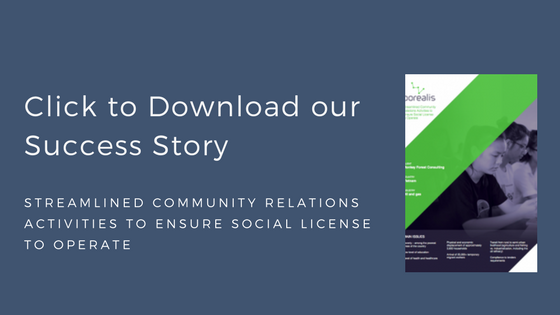Data management. 2 simple words, yet a big world of complexities. Since my first years in the Corporate Social Responsibility and social performance industries, I’ve seen too many clients bang their head against the wall trying to make sense of their data. And for good reason: things can get quite complicated very quickly. Plus, there are some important risks and costs to having unstructured data. We’ve seen clients that were using up to 10 independent databases to manage the information of a single project. Good luck trying to report on your activities or quickly answering a question about that project…
So you’ve been mandated to make a list of all the vendors that provide a system to manage your stakeholder engagement data, but don’t know where to start? Don’t worry, it’s not all that complicated. Well, it shouldn’t be. I’ve developed a bulletproof approach to determine which solutions can help you manage all your social performance / corporate social responsibility data. The best part? There are only 4 major factors to assist your decision-making. Make sure you get a “Check!” next to each one of these and you’ll be sure to choose a system that’s right for you.
1. The system aligns with both current and future needs of your project (or company)
Sounds simple enough, right? Still, people will often overlook this point. Most common mistake: thinking only of current needs – let’s face it, many of you who are seeking a solution are currently working with a tight deadline and wish you had found the right stakeholder relationship management (SRM) software yesterday. Plus, current needs are indeed important. But if you find yourself having to repeat this exercise in a year or two, you’ll hate yourself as much as the solution you’ve chosen.
A trend that has been popular is choosing a vendor that’ll develop a customizable system, which they build from the ground up and based on your needs. But there’s a catch to this method: in addition to taking A LONG time to actually get the system (we’re talking months to even years), these will often be built using current needs, or planned needs. As well as we can prepare ourselves for project management, we all know that some events or situations we had not planned for will arise. So how will your custom system, which only caters to current and planned needs (instead of relying on solid expertise), be of any help in managing the unplanned? Another important issue to consider with custom systems is how well they will age. If your needs change, you’ll have to return to the drawing table with your vendor and reinvest to customize the system again to fit your new needs. Add to that the exhausting timeline.
Here’s something you should remember: if you’re looking for an information management software for social and environmental performance, there is no way you’re the first person in line. Although still quite niche, this market has been growing tremendously over the last decade, and nowadays it’s not only mining or oil and gas companies that we see interested in reporting on their activities – it’s organizations coming from a wide variety of industries, including pipelines, transport, agroforestry, renewables, and even utilities. What is fuelling this sudden need for reporting? Accountability and corporate citizenship. People want to know what companies (private and public) are up to. They want to know who is doing business in their backyard, what they are doing and how they are doing it. So with all these companies looking for a tool to report on their activities, there has to be software that meets your needs currently available on the market.
Instead of reinventing the wheel with a custom system, look for a standard stakeholder management application. Advantages will include:
- Fast deployment
- Cutting-edge / evolving technologies
- Configuration options to suit your project
- Ease of integration of your business processes
- Cloud-based (no investment in hardware)
- Years of expertise built into the product
- Guidelines that integrate CSR best practices
- Pre-defined reporting and analysis dashboards
2. The stakeholder engagement application can be up and running in less than a month
Of all resources we have on this Earth, time has got to be one of the scarcest. And in business, time literally equals money. As you’re seeking a system to track engagements with your project stakeholders, here’s something you should remember: people will not wait until you have a system and processes into place to talk with you. Especially if you’re already impacting their everyday lives. That’s why being able to have an operating system in under a month is number 2 on my checklist. Every contact with communities where you operate is important – and so is tracking it, even if you’re still planning your project on paper.
This is another point rooting for standard systems vs. custom ones. How so? Well since time is so important, the last thing you’d want is for your field teams of experts to waste their time deploying systems which you are not even sure will work or look like. It’s a shift in mindset: rather than having the staff working for an information management system, you get a system that works for your staff.
3. The social performance software aligns with best practices
4. Level of dependence on the software provider
The best systems or applications are always the ones that are easy to use, fun to navigate through and that don’t make us feel dependent on a third party. Point in case: of all the apps on your smart phone, which ones do you find yourself using the most? The ones that make your life simpler, or the ones that make you feel like you’re wasting your time? Let me clarify. Let’s say you have to choose between 2 apps to shop for flights. Both let you search for international destinations, rank flights per price / number of stops, offer alternative travel dates and let you save search history. But what if one of them sends you a push notification when your flight reaches its best price? Wouldn’t that be your application of choice? You’ve got nothing to do but wait for a low price alert to book your flight, rather than having to open the app and re-launch your search to get new results every day.
Of course, social performance software is more complex than a cheap flight fare finding app, but you’ll still be a lot more prone to use it if it comes with a good level of freedom. And that’s the final nail in the coffin for custom systems: for every little modification you’ll want to make, you’ll have to contact your vendor to see if they can make it. Standard systems on the other hand, come with a long list of editable parameters that you’ll be able to change from your application settings.
In the end, you’re they key to the success of your stakeholder engagement app
About Boréalis
Boréalis online stakeholder engagement software is used by organizations around the world to successfully engage stakeholders and secure social license to operate in a wide range of industry sectors. To request a free custom demo of our software, contact us.






